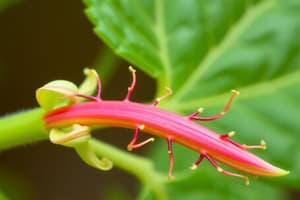Podcast
Questions and Answers
What is the primary focus of plant morphology?
What is the primary focus of plant morphology?
- The form and structure of plants (correct)
- The genetic makeup of plants
- The study of plant diseases
- The ecological interactions of plants
Which function is primarily associated with leaves in plants?
Which function is primarily associated with leaves in plants?
- Reproduction
- Water absorption
- Photosynthesis (correct)
- Nutrient transport
What role do fruits play in the life of a plant?
What role do fruits play in the life of a plant?
- Protecting seeds (correct)
- Photosynthesis
- Water retention
- Wind dispersion
How do plants primarily adapt to their environments?
How do plants primarily adapt to their environments?
Which of the following best describes plant physiology?
Which of the following best describes plant physiology?
What is the purpose of plant taxonomy?
What is the purpose of plant taxonomy?
Which plant process releases energy from sugars?
Which plant process releases energy from sugars?
What does plant genetics primarily investigate?
What does plant genetics primarily investigate?
Flashcards
Botany
Botany
The scientific study of plants, including their structure, function, evolution, and classification.
Plant Morphology
Plant Morphology
The study of the form and structure of plants.
Photosynthesis
Photosynthesis
The process where plants use light to make food.
Plant Physiology
Plant Physiology
Signup and view all the flashcards
Plant Ecology
Plant Ecology
Signup and view all the flashcards
Plant Taxonomy
Plant Taxonomy
Signup and view all the flashcards
Plant Genetics
Plant Genetics
Signup and view all the flashcards
Plant Reproduction
Plant Reproduction
Signup and view all the flashcards
Study Notes
Introduction to Botany
- Botany is the scientific study of plants, encompassing their structure, function, growth, evolution, classification, and distribution.
- It encompasses a wide range of subjects, including plant morphology, physiology, ecology, genetics, and taxonomy.
- Plant diversity is vast, ranging from microscopic algae to towering trees.
- Botany plays a crucial role in understanding ecological systems and human interactions with the plant kingdom.
Plant Morphology
- Plant morphology studies the form and structure of plants.
- Key features include roots, stems, leaves, flowers, fruits, and seeds.
- Roots absorb water and nutrients from the soil.
- Stems support the plant and transport substances between roots and leaves.
- Leaves are primarily responsible for photosynthesis.
- Flowers are involved in reproduction.
- Fruits develop from flowers and protect seeds.
- Seeds contain the embryo and nutrients for germination.
- Different plant groups exhibit variations in these morphological features.
Plant Physiology
- Plant physiology studies the functions and processes within plants.
- Key functions include photosynthesis, respiration, transpiration, and movement of substances.
- Photosynthesis converts light energy to chemical energy, producing sugars.
- Respiration releases energy from sugars for plant activities.
- Transpiration is the loss of water vapor from leaves.
- Plant hormones regulate various physiological processes.
Plant Ecology
- Plant ecology examines the interactions between plants and their environment.
- Key factors include light, temperature, water, nutrients, and competition.
- Plants adapt to different environments through specific adaptations.
- Plants play a vital role in maintaining biodiversity and ecological balance.
- Interactions with other organisms, like animals and microbes, are important ecological factors.
Plant Taxonomy
- Plant taxonomy classifies and names plants.
- A hierarchical system, starting with broad groups (kingdom, division) and moving to more specific ones (genus, species).
- Uses morphological, anatomical, and molecular data to categorize plants.
- Different taxonomic systems exist, but the Linnaean system is a common framework.
Plant Genetics
- Plant genetics explores the heredity and variation in plants.
- Genetic information is encoded in DNA.
- Variation in genes leads to differences in traits and adaptations.
- Plant breeding techniques are used to improve crop yields and develop new varieties.
- Plant genomes and genetic analysis provide insights into evolution and function.
Economic Importance of Plants
- Plants are crucial to human survival and well-being.
- Food, medicine, fiber, building materials, and fuel are derived from plants.
- Agricultural practices focus on cultivating plants for food production.
- Plant-derived products are essential for various industries.
- Understanding plant biology is vital for sustainable agriculture and food security.
Studying That Suits You
Use AI to generate personalized quizzes and flashcards to suit your learning preferences.



